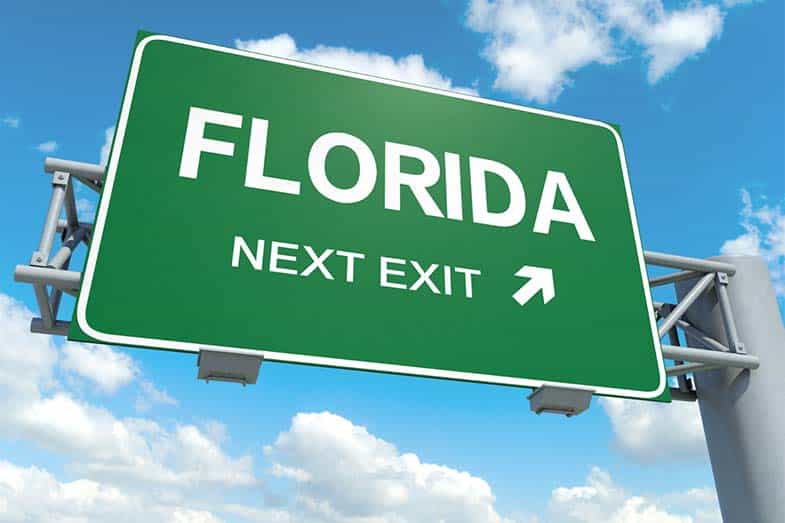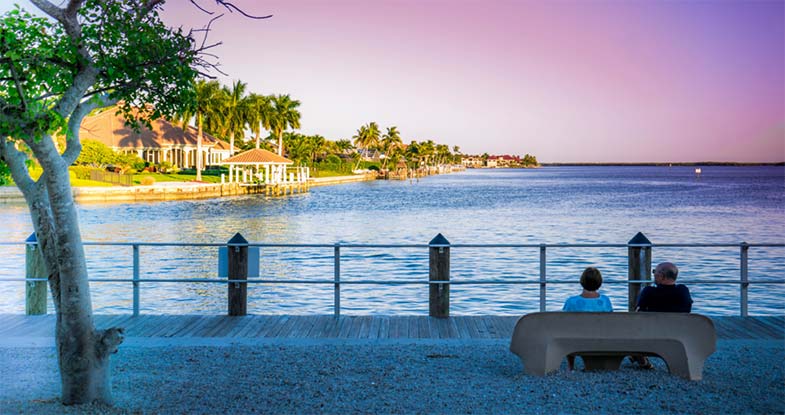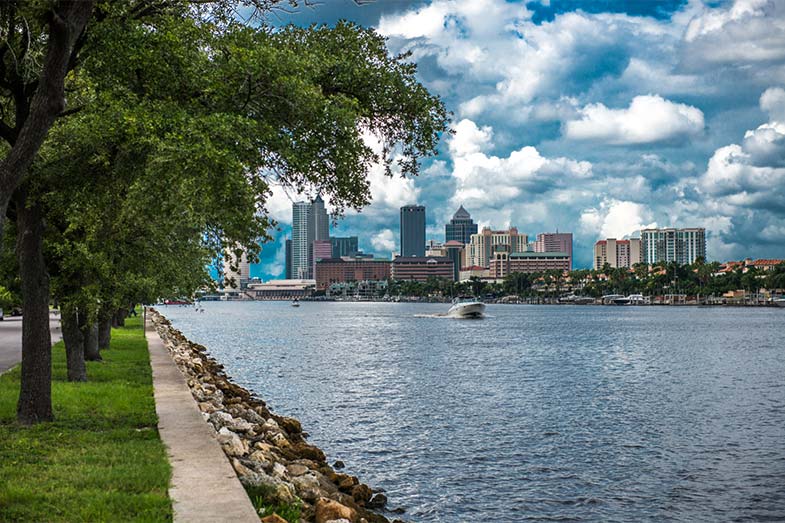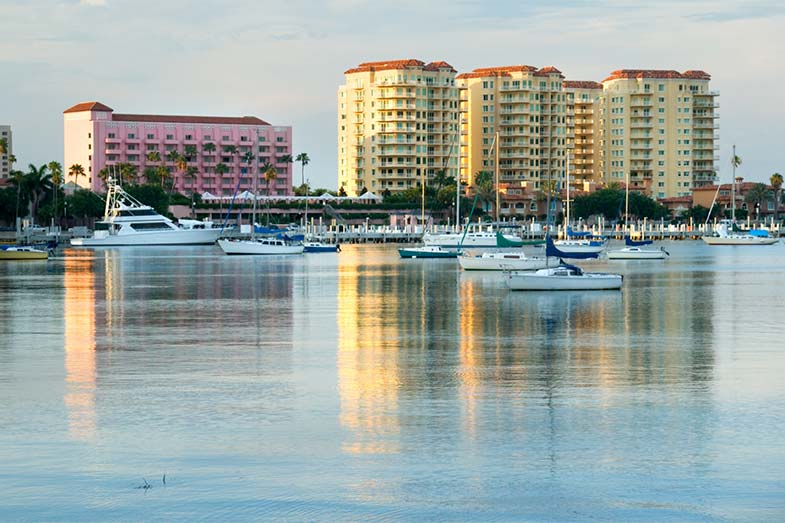Moving from Michigan to Florida (or to any out-of-state location, for that matter) is never an easy decision to make – especially if you’ve lived surrounded by snow for most of your life. But circumstances such as a rare job opportunity or a shift in lifestyle may push you to ask yourself, ‘Should I move to Florida?’ Well, you’re just in luck — as this guide talks about your options and what else needs to go into your future preparations.
When moving from Michigan to Florida, it is important to know about the neighborhood you’re relocating to and how it ties up with your lifestyle, employment, safety, and needs. Once that’s settled, you will need to consider whether you can afford to live there.
The above statement is pretty self-explanatory. However, it isn’t always the process that most migrants go by. Some start by checking the most affordable cities and picking the nicest communities. Others give precedence to location, preferring a beach-front property close to the city.
Whichever route you take, this article aims to help you decide on whether or not to trade in fallen autumn leaves and snowball fights for forever summers in the Sunshine State.

A Bird’s Eye View of Florida
Florida is diverse, and I don’t mean its cuisine or cultural influences. Despite being topographically flat, it is essentially a varied state — with bits and pieces of the U.S. put into one location. For example, Tallahassee exudes the southern vibe of Alabama, Miami is as suburban as New York, and Orlando feels as crowded as any other downtown city in the greater metropolitan America. The one major difference it has from other states is its perennial summery weather.
How Florida Compares to Michigan
Conversely, Michigan offers topographical variations — from breath-taking waterfalls to sweeping sand dunes to Upper Peninsula Mountains. It is chilly for most of the year (saves you from turning the A/C on) and filled with white, pillowy snow during winter. Snowmobile rides and other winter sports are the ‘in’ thing from November to March. Outside of the cold season, residents and tourists highly anticipate the short-lived spring and summer and get to marvel at the change of the seasons all year round.
If Florida’s economy mainly circles around tourism, Michigan is the epicenter of the automotive industry in the U.S. and runs predominantly on the production and assembly of automobiles. The U.S.’ Big Three (Ford, General Motors, and Chrysler) are headquartered in the state. Housing-wise, median housing costs can range from as low as $57,600 in Albion to as high as $407,400 in Ann Arbor. But even so, the state’s hourly wages give most Michigan cities a good income-to-home-cost ratio.
If we were to determine the cheapest place to live in Michigan based on the overall cost of living, it would be in Ishpeming or Old Ish. You will spend as much on food, healthcare, transportation, utilities, and housing in Ishpeming, MI, as you would in Bartow, FL. Other noteworthy, cost-effective places in Michigan are listed in the table below:
| Location in MI | Cost of Living vs. U.S. National Average |
|---|---|
| Jackson | – 25% |
| Iron Mountain | – 21% |
| Manistee | – 19% |
| Alpena | – 18% |
| Menominee | – 16% |
| Bay City | – 14% |
| Owosso | – 12% |
| Saginaw | – 11.5% |
| Flint | -11.9% |
| Muskegon | – 11.1% |
Reasons to Move to Florida

The difference in state-wide cost of living between Michigan and Florida is 6.3% — and yet, about 950 to 1,000 folks move to the Sunshine State each day. This increase may or may not be a lot for some, given their source of income. Nonetheless, let’s look at other factors that’ll help you weigh the pros and cons between the two states further.
Lovely Weather
Whether it’s the East/West Coast or northern/southern part of the state, Florida offers a warmer climate year-round. North Florida may witness some snow now and then, but not as harsh as Midwestern winters in Michigan. On the other hand, South Florida rarely experiences snow (if not at all) and is perfect for ‘snow birds’ wanting to break free from the cold of the north. Floridians, especially those residing near the coastlines, get to enjoy breezy, warm weather with temperatures ranging within 70 — 80 °F (21.1 — 26.7 °C) most days. You’ll see residents getting their daily dose of Vitamin D anywhere in the state.
Endless Supply of Beaches
As the only state bordering both the Atlantic Ocean and the Gulf of Mexico, you will never run out of beautiful beaches to go to every weekend. Florida has about 663 miles of coastline — meaning you’ll be doing a lot of beach-hopping (something you can’t do that easily in Michigan). Even if you don’t end up owning a beach-front home, getting to turquoise waters and beautiful white sand is just a little over an hour’s drive away. Plus, you’ll have Sanibel Island, Clearwater Beach, South Beach, and the highly-acclaimed Sarasota Siesta Public Beach (among others) to choose from.
Career Opportunities
For the longest time, tourism and agriculture had been the state’s ‘bread and butter.’ And if you’re in any one of these industries, your career is sure to thrive. However, these two are not all Florida offers, as aerospace, international trade, life sciences, and finance sectors also form part of its robust economy. Florida’s bustling collegiate culture, too (thanks to its universities and colleges), helps create more jobs in the state.
Tax Benefits
Florida has a slightly higher COL (Cost of Living) index than the U.S. But it does compensate for this drawback by not charging its residential and non-residential workforce any state income tax. As a migrant, this means that your hard-earned money can go a lot farther here than in Michigan. Of course, the extent of your salary will still be dependent on other factors — not to mention that some areas in Florida have higher transportation and utility prices than others. But if you move with a pay increase and choose a home with modest amenities in a near-inland neighborhood, then that lack of state income tax will go a long way in stretching the value of your wages.
Indoor & Outdoor Fun
The state’s forever summers make an ideal setting for tons of recreational activities — both indoors and outdoors. From all-day shopping, exciting island adventures, and marine activities to golfing, nightlife, and thrilling theme-park rides, Florida has got you covered. What’s more, you get to enjoy these world-class theme parks at a discounted rate as a resident! You can go yachting, diving, paddle boarding, or be on a cruise and enjoy the majestic views above and below the sea. And if you love the outdoors, there are the Everglades, lots of trails, freshwater springs, and lakes to explore.
Change of Scenery
Relocation doesn’t necessarily have to be circumstantial — sometimes, it is a personal choice. Being in the same place for years can get mentally and emotionally draining, especially if you live in a big, crowded city. Moving out of state opens a world of opportunities and helps you gain perspective through exposure to different cultures and attitudes. It may even give you a shot at revisiting a hobby or learning a new skill that you never thought you liked or needed. And what better place to embrace self-discovery and new beginnings than in a cultural melting pot like Florida!
And Reasons Not To

Since we’re on the topic of moving from Michigan to Florida, we might as well cover the drawbacks of moving to this warm, sunny state. Accounting for all the potential negatives of your decision is of utmost importance, especially if you plan to stay in the ‘Theme Park Capital of the World’ for the long haul:
Difficult to Acclimate To
Florida’s temperate climate is a welcome break from Michigan’s frigid winters. But for someone who isn’t acclimated to this type of weather, the constant heat and humidity can be oppressive. Neither the shade of trees nor your car’s A/C can hide you from the sun or prevent you from sweating profusely, especially during summer.
Lots of Thunderstorms
Weather can be fickle-minded, even nasty at times. The sun could be all out in the morning, but it could rain like cats and dogs in the afternoon. Thunderstorms and lightning strikes are common. And though rare, you are more likely to experience a hurricane if you live in any of the Northwest, Southwest, or Southeast Florida counties.
Driving Can Be Tedious
If you’re not a fan of monotonous, long-distance driving, then Florida may not be for you. The state is completely flat, which can make driving around tedious. You may opt for public transportation, but that, too, is limited in certain parts of the state. Encountering terrible drivers on the road only makes things worse.
The Wildlife
Living in a location surrounded by abundant nature and wildlife can be a blessing and a curse. In the case of Florida, the curse takes the form of large bugs, cockroaches, spiders, snakes, scorpions, and alligators (to name a few). At best, you’ll grow heavily reliant on mosquito repellents in your daily battle against those bloodthirsty suckers.
Not Many Historical Landmarks
While there are tons of top-notch amusement parks and nature trails in the state, there aren’t a lot of historical landmarks like St. Augustine and the Dry Tortugas. This is partly attributed to Florida’s low population count before air conditioning was invented in the 20th century.
Crime in Certain Cities
Tourism is a double-edged sword in Florida. It brings money to the state, but it’s also the reason for high crime rates and unsafe neighborhoods in certain cities. Touristy locations like Orlando and Miami are known for pickpockets, while Florida City and Opa Locka register high violent crime rates.
Overcrowding
The population is exploding, which means overcrowding in frequented spots like restaurants, shops, and reasonably-priced apartments. This increase in population density adds to the strain on Florida’s infrastructure and natural resources and contributes to habitat loss and water pollution. As it is, the state is experiencing declining flows, freshwater fouling, and disrupted ecosystems.
Miss Out on Seasons
Giving up on witnessing the progression of the four seasons will be especially tough for romantics. Sadly, it is a dear price to pay for turning your daily life into everyone’s coveted summer vacation. Not being able to go sledding, creating Olaf from ice, or taking photos with layered snow blankets as your backdrop is just as hard.
Cost of Living in Florida

Florida’s overall cost of living is a tad higher than the national average but is considerably lower than the latter in some areas of the state. That said, your monthly expenditure will depend on the lifestyle you’re accustomed to, as well as your priorities and definition of comfortable living. Though there are many areas in the Sunshine State where housing costs are cheaper than most, there may be corresponding trade-offs in the price of groceries, utilities, and other general expenses.
Housing costs, in particular, would vary depending on whether you intend to be a seasonal or permanent resident. If temporary, you may be better off looking for rentals in near-inland areas not too far from the buzz of the metro. If permanent, the timing as to when you do this will affect how much you spend on a home purchase. It is ideal to wait for the housing market’s off-peak season before buying. Otherwise, you’d end up paying for an overpriced home.
Finally, account for a change in wages. Although Florida intends to increase hourly pay to $10 effective this year, the state’s current minimum hourly wage is $3.50 less than what is considered a liveable wage in the US. So unless you’re relocating due to job opportunities and a higher offer or moving to a warmer climate to cut down on healthcare expenses, you may want to think things through.
Other Considerations Before Moving
At this point, you should be leaning towards either moving or not moving out of Michigan. If you haven’t yet decided on pushing through with an out-of-state move and want to assess your options surgically, below are things to know before moving to Florida that should enlighten you and help get things moving along:
| Criteria | Florida | Michigan |
|---|---|---|
| Public safety (Property & violent crime factored in) | 30th out of 50 U.S. states | 20th out of 50 U.S. states |
| Cost of Living Index | 102.8 vs. U.S. average of 100 | 89.6 vs. U.S. average of 100 |
| Housing (Median price/monthly rent) | $231,800 – $294,900 / $1,780 | $175,000 – $218,400 / $1,150 |
| Taxes (Combined rate) | 7.05% – inclusive of 0.83% property tax, 6% sales tax, 0.5% to 2.5% local taxes | 12.19% – inclusive of 1.64% property tax, 4.25% income tax, 6% sales tax, 0.5% to 1.5% local taxes |
| Transportation & Traffic | 7th overall – Commute time (#41) Public transit usage (#18) Road quality (#7) Bridge quality (#3) | 37th overall – Commute time (#23) Public transit usage (#27) Road quality (#30) Bridge quality (#35) |
| Unemployment Rate | 4.4% | 5.6% |
| Poverty Rate | 16.6% | 16.2% |
| Economy & Job Growth | 9th out of 50 U.S. states Industries – tourism, agriculture, finance, aerospace, life sciences, international trade | 19th out of 50 U.S. states Industries – manufacturing, tourism, agriculture, automotive, engineering, design & development, tech, forestry |
| Educational Opportunities | 3rd out of 50 U.S. states 1st in the U.S. for higher education | 37th out of 50 U.S. states |
| Weather & Climate | no seasonal variation 240 sunny days 55 inches of rainfall 49 °F (9.4 °C, winter) to 91 °F (32.8 °C, summer) | 170 sunny days 34 inches of rainfall 64 inches of snow 14 °F (-10 °C, winter) to 81 °F (27.2 °C, summer) |
| Food | Latin, Caribbean, Southern & European cuisines – Cuban sandwiches, key lime pie, conch fritters, Cedar Key clams, Apalachicola oysters, gator bites | African, Latin, Southern, Italian & European cuisines – Detroit pizza, tart cherries, Michigan apples, U.P. pasties, Oberon beer, Coney Island hotdog, Frankenmuth Chicken, Chipati, Paczkis |
| Culture, Diversity & Demographics | Latin, Caribbean, Cuban, African, European cultures White – 75.12% Black/Afro-American – 16.07% Other races – 2.99% Mixed races – 2.74% | Latin, Caribbean, Cuban, African, European cultures White – 78.41% Black/Afro-American – 3.79% Asian – 3.13% Mixed races – 2.92% |
| Recreation | Beach & island adventures Arts & music events Golf & sports Attractions – Disneyland, Wizarding World of Harry Potter, Legoland, SeaWorld, Fun Spot America, Aquatica, St. Augustine Ghost Tours, The Kennedy Space Center | Hiking, skiing & fishing Kayaking tours, arts & music events, wildlife sanctuaries Attractions – Frederik Meijer Gardens & Sculpture Park, Mackinac Island, Pictured Rocks, Henry Ford Museum, Detroit Institute of Arts, Windmill Island Gardens |
| Moving Expenses | $3,000 – $5,450 *Expect a 35% rate increase when moving during peak season and/or hiring professional movers | N/A |
When working out the cost of living in Florida, your moving expenses should be part of your calculations — unless you are relocating due to a job assignment and your company shoulders your moving costs. Expenses associated with moving from Michigan to Florida will ultimately depend on variables inclusive of the household size, origin and destination points, route, and timing of your move.
Best Cities to Move to in Florida

As already established, determining where to stay in Florida (and whether you should move in the first place) can prove challenging. After all, the state has a total of 282 cities to choose from. Each of these locations has a vibe and tempo of its own — some more urbanized or laid-back than others. Other factors like cost of living, employment, recreation, and sustainability (among others) also play a big part in your decision. The question ‘Is Florida a good state to live in?’ should be aptly answered by one of these top spots:
(Note: Population estimates are based on the 2022 report by worldpopulationreview.com and populationu.com)
Tampa
With excellent food, metropolitan amenities, powerhouse learning institutions, and robust healthcare infrastructure, it may be surprising that Tampa’s job growth ranks high on the affordability scale (8 out of 10) due to its low living and housing costs. Housing expenses in the city are 23% lower than the U.S. national average, making Tampa an excellent choice for families, start-up entrepreneurs, and young professionals wanting to diversify their career potential.
Its charming, culture-rich neighborhoods, pristine beaches, and booming economy are currently enjoyed by the city’s estimated population of 407,104. Perhaps, the only drawbacks you may want to ponder further are slightly higher utilities, lower wages, and congested roads every winter.
Orlando
If you have kids, Orlando is a great city to settle in. Thanks to tourism, Orlando is pretty clean — not to mention that it holds the most picturesque holiday destinations in the palm of its hand. Moreover, every theme park or attraction a child could dream of is there. Disney World, Legoland, and Universal Studios are but a few of these magical places. And let’s admit it, grown-ups enjoy these sites as much as (if not more than) kiddos do.
All this beauty and magic, however, come with a price. Housing costs average at $330,000, with rent prices picking up by 7% from last year alone. And unlike less-touristy spots in the state, Orlando may not be your ideal respite from the ‘hustle and bustle of life.’ The city may have recently taken a momentary break from all the frenzy. But during its peak months, expect lots of heavy traffic and about 70 million tourists adding to the chaos of its estimated population of 322,644.
Jacksonville
Jacksonville, the largest city in the state, ranks similarly to Tampa on the affordability scale (8 out of 10). Given the metro’s proximity to major cities like Miami, Orlando, and Naples, it has a thriving job market and is best-suited for free-spirited yuppies. In addition, the place has 80,000 acres of marshes, wetlands, and parks that would greatly appeal to nature-loving folks and retirees. Housing expenses in the city are 11% lower than the U.S. national average, with the cost of living approximately 30% cheaper than when living in New York.
Like most of Florida, the city provides top-caliber restaurants, cultural communities, arts, and music scenes, and stunning coastlines that are the pride of its 938,717-strong population. Jacksonville would be a perfect location for young families if it weren’t for its crime rates, about seven times higher than the country’s average.
Miami
Personally, one thing comes to mind about this city — it’s the phenomenal ’80s TV show Miami Vice. The storyline around organized crime and murder rates may have been exaggerated a bit. But every other aspect of Miami shown on television was as close to real as it can get. Even now, the metro boasts of diverse cultures, international business hubs, gorgeous beach views, and incredible nightlife. And for these very reasons, it has drawn both yuppies and families to its shores.
From its slew of entertainment options and incredible food choices down to its year-round summer weather and beach-front properties (and more), it is but natural for Miami to score a 6 out of 10 on the affordability scale. This may not be the perfect spot for you if you are beginning to grow your career, build a family, or are in the tourism industry. More so if you hate traffic, as you may find yourself — along with Miami’s estimated population of 2,723,198 — wrestling your way through roads.
Cape Coral
This city of 203,930 strong is nestled in the southwest region of Florida, along the Gulf Coast. Thanks to its geographical location, Cape Coral offers convenient access to nearby beaches on Sanibel and Captiva Islands, affordable waterfront living, and a much lower crime rate than other major cities in the state. Median housing costs play between $238,000 and $358,400, with a recent appreciation rate of approximately 21.7%.
Cape Coral (otherwise known as the Waterfront Wonderland) scores fairly okay on the affordability scale (7 out of 10) and is among the most preferred places by retirees on a budget. Potential downsides, however, are that 20% of its current population are seniors, and the way of life is not as fast-paced as in metropolitan areas.
Gainesville
An inland city farther from the coastlines, Gainesville is home to the University of Florida and houses a rather young community — with only 10% of its estimated 134,993 population comprised of seniors. It ranks 7/10 on the affordability scale, has a median housing cost ranging from $228,000 to $262,200, and boasts of a 4.3% unemployment rate. The city compensates for the lack of stunning beaches with its flourishing nature, scenic trails, and seven state parks.
Special Mentions

The crime rate, culture, and job opportunities aside, here are other places to consider if you are in search of affordable places to live in Florida:
| Location in FL | Cost of Living vs. U.S. National Average |
|---|---|
| Bartow | – 16% |
| Tavares | – 16% |
| Homosassa Springs | – 15% |
| Lady Lake | – 14% |
| Lakeland | – 13.6% |
| Dade City | – 13% |
| Lake Wales | – 13% |
| Pensacola | – 11.8% |
| Live Oak | – 11.3% |
| Palm Bay | – 11% |
| MacClenny | – 10.2% |
| Kissimmee | – 10% |
| New Port Richey | – 8% |
| Milton | – 8% |
| Dunedin | – 8% |
| Daytona Beach* | – 7% |
| Edgewater | – 6% |
| Tallahassee | – 6% |
| Saint Petersburg | – 5.5% |
| Clearwater | – 5.4% |
This (non-exhaustive) list covers other locations in the state that likewise offer affordable abodes for budding professionals, young families, and even retirees. Additionally, there are tons of things to revel in and explore, from Port St. Lucie to the state’s capital. Take your pick from museums and annual festivals to a wide range of cuisines and the local commute.
Since these spots are far from the city lights and the maddening crowd, you are guaranteed peace and quiet — something you will barely get from more-touristy destinations. But should you prefer first-class healthcare and real estate, excellent schools, pristine beaches, and expansive golf courses, you may want to explore the more up-class offerings of the state — West Palm Beach, Fort Lauderdale, or Naples — but for a premium.
Conclusion – Moving from Michigan to Florida
Moving from Michigan to Florida will give you more than just sun, sea, sand, and smiles. There will be trade-offs in moving to the Sunshine State — some of greater weight than others. While you’ll lose the ability to see the first drop of snow, you’ll gain a vibrant, laid-back lifestyle. Not only will moving out of state cure your winter blues, but it will also give you peace of mind — knowing that your vehicle won’t hydroplane when you drive.
When it comes to supposed dangers associated with being a permanent resident of Florida, there are ways to remedy them. Installing hurricane shutters, getting insurance to cover you against natural disasters, and keeping a mental note of evacuation routes will go a long way in protecting you, your home, and your finances. As for minor inconveniences, having a trusted sunscreen, insect repellents, large brim or bucket hat, and breathable clothing in your arsenal would suffice.
